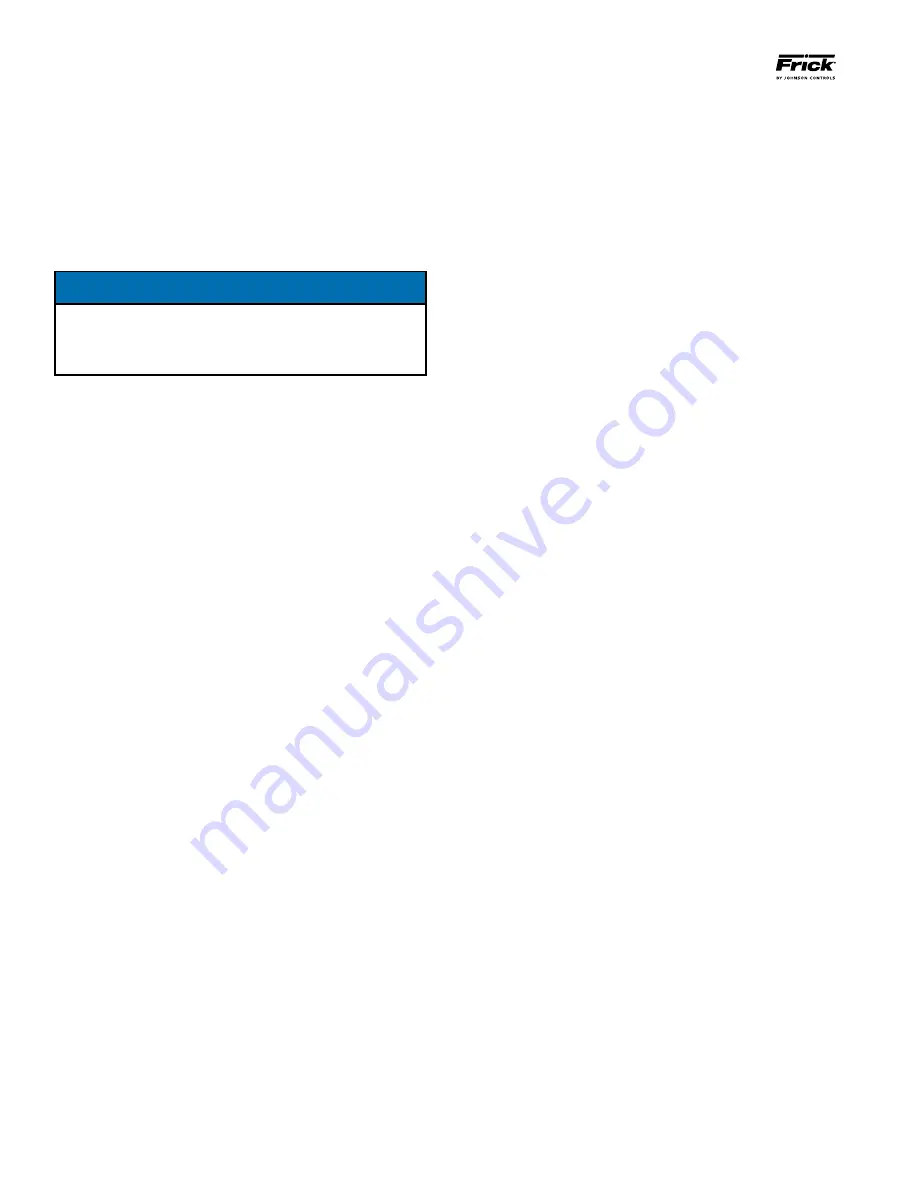
ECH EVAPORATIVE CONDENSERS
MAINTENANCE
140.910-IOM (DEC 13)
Page 18
Mechanical Makeup Valve Assembly
A float-operated mechanical water makeup assembly is furnished
as standard equipment on the unit. The standard makeup as-
sembly consists of a corrosion resistant makeup valve connected
to a float arm assembly actuated by a polystyrene-filled plastic
float. The float is mounted on an all-thread rod held in place by
wing nuts. The cold water basin operating water level can be
adjusted by repositioning the float and all-thread rod using the
wing nuts provided.
NOTICE
If the unit has been ordered with the optional electric wa-
ter level control package or is intended for remote sump
application, a mechanical water makeup valve will not be
provided.
Inspection and Maintenance:
•
Inspect the makeup valve assembly monthly and adjust if
necessary.
•
Inspect the valve annually for leakage. Replace the valve
seat if necessary.
•
Maintain the makeup water supply pressure between 15
psig and 50 psig for proper operation. Johnson Controls
recommends a surge protector (provided by others) for
pressures over 50 psig.
•
Set the initial basin water level by adjusting the wing
nuts, so that the makeup valve is completely closed when
the water level in the cold water basin is at the overflow
connection.
•
With the design thermal load and the average water
pressure (15 to 50 psig) at the valve, the above setting will
produce operating water levels as stated in Table 2.
•
If the thermal load is less than the design load at the time
of unit start-up, the procedure may produce operating
levels greater than those shown in Table 2. If operating
levels are higher than specified, readjust the float in order
to attain the recommended operating level.
•
Closely monitor the water level in the cold water basin and
adjust the level if necessary during the first 24 hours of
operation.
•
Operating at the recommended water level will ensure that
the unit basin contains sufficient water volume to prevent
air entrainment in the circulating pump during system
start-up.
OPTIONAL ELECTRIC WATER LEVEL
CONTROL PACkAGE
As an option, an electric water level control package is avail-
able in lieu of the mechanical makeup assembly. The package
consists of a probe-type liquid level control assembly and a
slow-closing solenoid valve. Stainless steel electrodes, factory-
set at predetermined lengths, extend from an electrode holder
into the cold water basin.
Inspection and Maintenance:
•
Clean the stainless steel electrodes periodically to prevent
accumulations of scale, corrosion, sludge or biological
growth, which could interfere with the electrical circuit.
•
The water level is maintained at the recommended
operating level regardless of the system thermal load.
Therefore, it is not recommended that the operating level
be adjusted.
•
During the start-up of units equipped with the electric
water level control package, bypass the control unit in
order to fill the unit to the overflow connection.
SYSTEM CLEANING
Coil Cleaning
Both the inside and outside of the heat exchange coil may require
occasional cleaning. The chemicals used must be compatible
with the materials being treated. For example, the standard coil
outside is galvanized steel. The inside of the coil is black carbon
steel. For finned coils, the coil cleaning must be careful not to
damage the fins (outside of the coils) and the coils themselves.
For specific recommendations on coil cleaning, contact a quali-
fied consultant.
Weld Byproduct Cleaning
The installation and manufacturing processes commonly used for
field assembly of steel-piped systems may leave weld byproducts
inside coils and connecting piping (especially in refrigeration
systems). It is common practice to install filters and/or strain-
ers that remove contaminants during initial system operation.
Shortly after system start-up, the filters and/or strainers should
be cleaned or replaced.
WATER TREATMENT
A proper water treatment program, administered under the
supervision of a competent water treatment specialist, is an
essential part of routine maintenance to ensure the safe opera-
tion and longevity of evaporative cooling equipment, as well as
other system components.
Bleed Rate
•
In evaporative cooling, evaporation of a small portion of the
recirculating spray water as it flows through the equipment
causes the cooling effect. As this water evaporates, the
impurities originally present remain in the recirculating
water. The concentration of the dissolved solids increases
over time and can reach unacceptable levels.
•
In addition, airborne impurities are often introduced into the
recirculating water. If these impurities and contaminants
are not effectively controlled, they can cause scaling,
corrosion, and sludge accumulations that reduce heat
transfer efficiency and increase system operating costs,
potentially shortening the useful life of the equipment.
•
The degree to which dissolved solids and other impurities
build up in the recirculating water may be defined
as the cycles of concentration. Specifically, cycles of
concentration is the ratio of the concentration of dissolved
solids (for example - chlorides, sulfates, etc.) in the
recirculating water to the concentration of the same
material in the makeup water.





















